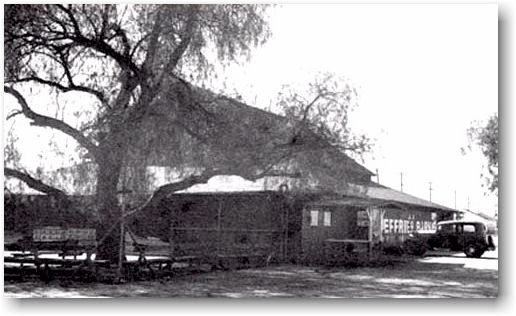
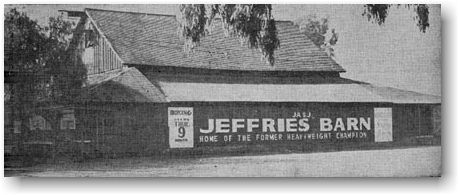
The Jeffries Barn
By Wes Clark
James Jeffries is considered to be one of the great heavyweight boxers of his era, perhaps the best of all time. He owned Burbank property on the corner of Victory Boulevard and Buena Vista Avenue in Burbank. On that property stood the Jeffries Barn, where Thursday night boxing matches were held from 1931 to Jeffries' death in 1953. It is interesting to note that John Garfield's big boxing scene in the Dead End Kids film "They Made Me a Criminal" (1939) was filmed in Jeffries' barn. After Jeffries' death the barn was dismantled and moved to the Knott's Berry Farm amusement park in Orange County. The land was a vacant lot until 1976, when a shopping plaza was built. From "A History of Burbank" (1967, Burbank Unified Schools): In 1904, national attention was drawn to Burbank when James J. Jeffries, the heavyweight boxing champion of the world, bought 107 acres for a ranch on Victory Boulevard. He paid $2,000 down and assumed a $10,000 mortgage. Only ten acres were placed under cultivation, and the rest was sagebrush and sand. Jeffries later developed another 93 acres and planted alfalfa. The market price for alfalfa dropped shortly after this time and it did not pay Jeffries to harvest his crop. He decided to put cattle on the land to eat the alfalfa. This proved to be a prosperous enterprise. Jim Jeffries became one of the country's foremost suppliers of thoroughbred bulls. Most of them were sold in Mexico and South America thus establishing Burbank's first foreign trade relations. Jeffries built a large ranch home and a barn on the corner of where Victory Boulevard and Buena Vista Street now intersect. According to my father-in-law Don Bilyeu (who lived in Burbank at the time and visited the Jeffries Barn a number of times to watch fights), the house and barn were separated by Buena Vista. The house was on the southeast corner (where a shopping plaza is now), and the barn was located on the south west corner (where Ralph's front parking lot is now). Jeffries gradually sold parts of his ranch until only his home and barn were left when he died, March 3, 1953. The barn may now be seen at Knott's Berry Farm where it was moved to make room for a labor union building which used to occupy the site. The home deteriorated after Jeffries died and was torn down years ago.
A special 1945 birthday edition of The Barn News is here.
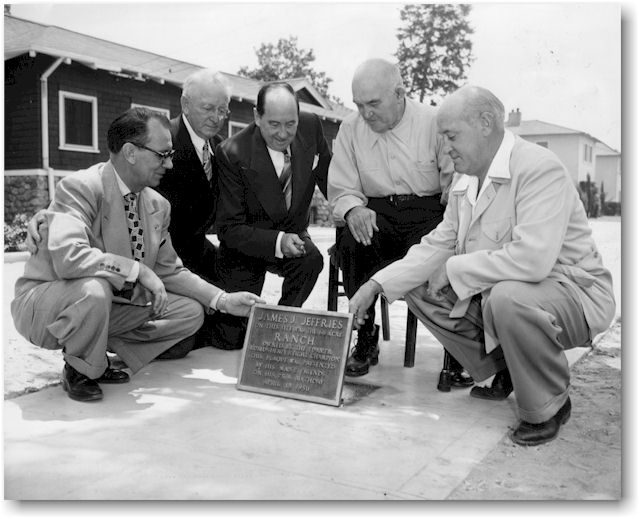
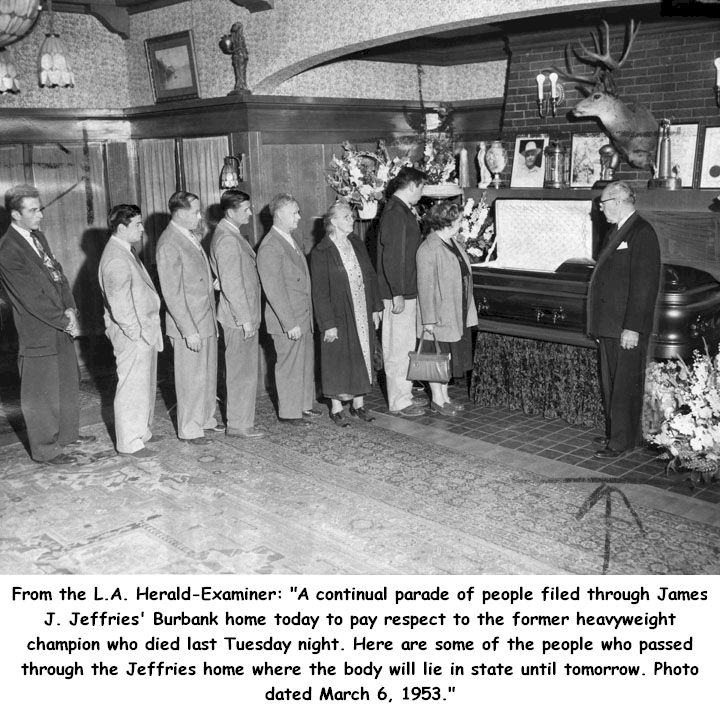
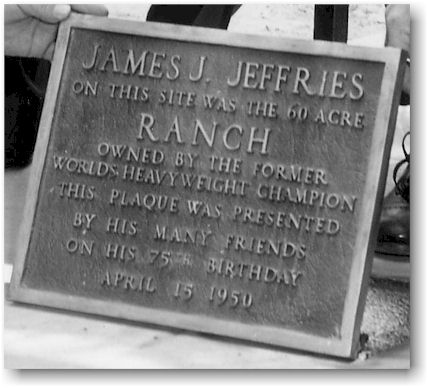
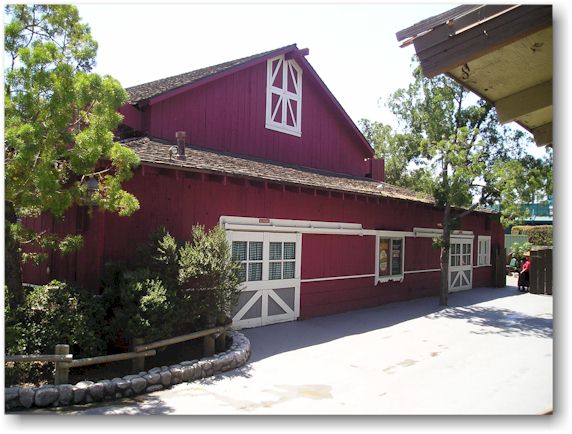
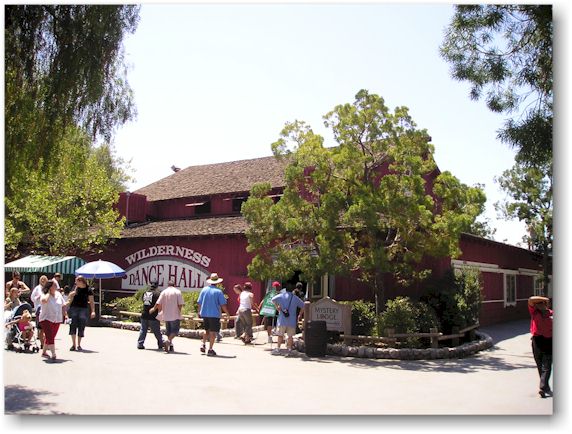
Photos from a visit to the Jeffries Barn at Knott's Berry Farm
"The Boilermaker"
Some photos
1904 Bout Ticket
Barn interior
At the 1904 bout
Bag and bell
Provided by the Carroll Area Historical Society
Jim Jeffries
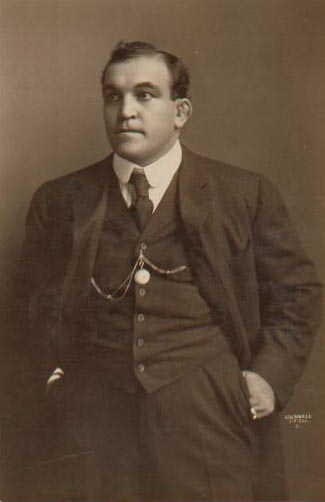 James J. Jeffries was born in a two-story log cabin near the corner of Carroll Northern and Basil Western Roads on April 15, 1875, the son of Alexis and Rebecca (Boyer) Jeffries. The family moved to California when Jim was about seven years old.
James J. Jeffries was born in a two-story log cabin near the corner of Carroll Northern and Basil Western Roads on April 15, 1875, the son of Alexis and Rebecca (Boyer) Jeffries. The family moved to California when Jim was about seven years old.
After graduation from high school Jeffries worked a number of jobs, including one as a boilermaker - thus giving him the nickname for his later professional boxing career. A natural athlete and a quick study, he was soon moving up in boxing circles and soon earned a reputation as an intelligent fighter who could take "inhuman" amounts of punishment.
He defeated Bob Fitzsimmons in New York in 1899 to claim boxing's highest prize and defended the title seven times, which was unusual for the time as many champions would not risk it. He retired undefeated in 1905, saying, "There is no one left to fight."
Coaxed out of retirement in 1910 for a fight with then world heavyweight champion Jack Johnson, Jeffries was out of shape and a shell of his former self but still put up a good fight before losing in the 15th round with a TKO.
He went back to retirement at his Burbank, California, ranch where he continued to train young boxers. Jeffries died on March 3, 1953. Jim Jeffries was named to the International Boxing Hall of Fame and is considered by many experts to be one of the top three boxers of all time.
James Jeffries, the World's Heavyweight boxing title holder from 1899 to 1905, was born in Carroll, Ohio. Although James lived in California as an adult, Carroll residents always considered him their own. (It is believed that James lived in Carroll until the age of 6, when his father, a Methodist minister, moved the family of eight children to California. )
Carroll residents reveled in Jim's six successful title defenses during his reign as "World Heavyweight Champion. II In 1905, he chose to retire undefeated. At the age of 35, Jim decided to come out of retirement and lost to the great champion, Jack Johnson, in what was termed the "fight of the century" on July 4, 1910.
The day after the fight, The Dispatch compared Jeffries loss to the only other "major" tragedy that had confronted the tiny Fairfield County town 30 years before. "Never since the day the body of Jim Jeffries' grandfather was snatched from its peaceful resting place in the little cemetery at Carroll has that town been so deeply cast into gloom as when the news of the big fight reached there on Monday evening announcing that Carroll's idol had bitten the dust in the ring at Reno.
Jim's grandfather was buried in the cemetery, and shortly afterwards it was discovered that the grave had been opened and that "body snatchers" had been at work. The little town was stirred into a furor and a searching party visited every medical college in Columbus without avail. The body was never located, but it has been believed in Carroll that medical students in Columbus had stolen it.
That incident has since been forgotten in Carroll, but the boxer's memory still lives on street signs that greet the visitor with the news that it is the birthplace of Jeffries, the former heavyweight champion. He died in California in 1953.
(This article was written by Bob Hunter, a Sports Reporter for the Columbus Dispatch and was contributed by the Village of Carroll Municipal Office.)
James J. Jeffries signature, 1942
Jeffries Barn News (9/30/1944)
Various James J. Jeffries images
James J. Jeffries and Hoyt Jones, early 1930s
Auto racing (!) at Jeffries Ranch (undated - 1930's?)
James J. Jeffries, Jeffries Center sign
Contributor Don Ray notes: "In 1954, a developer planned to build a million-dollar hotel at the site of Jim Jeffries Barn that was on Victory Blvd., just west of Buena Vista. The front of the barn (the west side) was just about exactly next to the current Ralphs Market. His home was across Buena Vista in what's now the parking lot of what they call The Landmark Center. Today, the Jeffries Barn is located at Knott's Berry Farm." The Valley Hotel was never built.
James J. Jeffries posthumously inducted into the National Boxing Hall of Fame (NBHOF)
Update 16 July 2019: I am reading Dickie Moore's Twinkle, Twinkle Little Star, but Don't Have Sex or Take the Car, a memoir about being a child star. The following passage about Jane Withers' 15th birthday party at the Barn is in it (the voice is Dickie Moore's):
Jane's fifteenth-birthday party, with a Western theme, caused Cora Sue (Collins) discomfort. The scene: Jim Jeffrey's Barn in the San Fernando Valley near Hollywood. Many horses used in films were trained and boarded there, and the rustic Western buildings served occasionally as film locations.
Cora Sue developed early. By fifteen, she was a knockout, cleavage and all. At the barn dance, she wore a scoop-neck blouse: "A photographer took me to a hay wagon and had me bend over supposedly looking for a needle in a haystack. I was so foolish I went for it. When the picture came out in a magazine, after being airbrushed, Mother dutifully put it in my scrapbook. That's when I saw it. I thought I looked like Jane Russell. It gave me a terrible complex. So I burned all my scrapbooks and every still of myself I could get my hands on."
Many of the guests including me arrived at Jeffrey's Barn in chauffeur driven hay wagons. Jane rode a horse. She wouldn't ride with any of us for fear of offending people on another wagon. Leo Carillo, a popular adult actor who owned vast stretches of prime acreage, and who for years rode his magnificent palomino horse (with silver saddle) at the head of every Hollywood parade,rode with Jane. He stayed for the party.
Ranch hands were preparing the barbecue as we arrived. Gingham, denim, and cowboy boots were the order of the day. But I wore tennis shoes because Mother had said, "It seems a waste to buy cowboy boots just to wear at a party."
To my horror, the party got around to square dancing. "Swing your partner to the right!" the caller yelled into the microphone, as the fiddlers played. I went left.
During a break in the dancing, Sidney Miller took the microphone and introduced the guests: Judy Garland, Mickey Rooney, Darryl Hickman, Freddie Bartholomew, Jackie Cooper, Donald O'Connor, Gene Reynolds, Cora Sue Collins, Marcia Mae Jones, Peggy Ryan, Edith Fellows, and members of the Watson clan, including Bobs and Delmar these and many more.
Prizes were offered for the best costumes. Delmar Watson smiled as he recalled: "Sidney was on the podium and he kept trying to get people to come up to get a prize and nobody would go up. We were all bashful. He begged us: 'Anybody come up I'll give you a prize!' Finally, he ended up saying. "I'll take the prize.'" Mickey Rooney played the drums and left. Donald O'Connor danced with Peggy Ryan. Bobs Watson (youngest of the guests) threw hay at cars as they went by. Edith Fellows and Bobby Jordan (a former "Dead End Kid") clung to each other, enraptured, paying no attention to the music. Suddenly, scores of balloons were released and Jane announced that attached to some of them were tags for door prizes. One balloon descended on Bobby and Edith. They won a baby goat. Edith's grandma let her keep it until it ate her flowers, then Joel McCrea, who owned a ranch, took it off her hands.
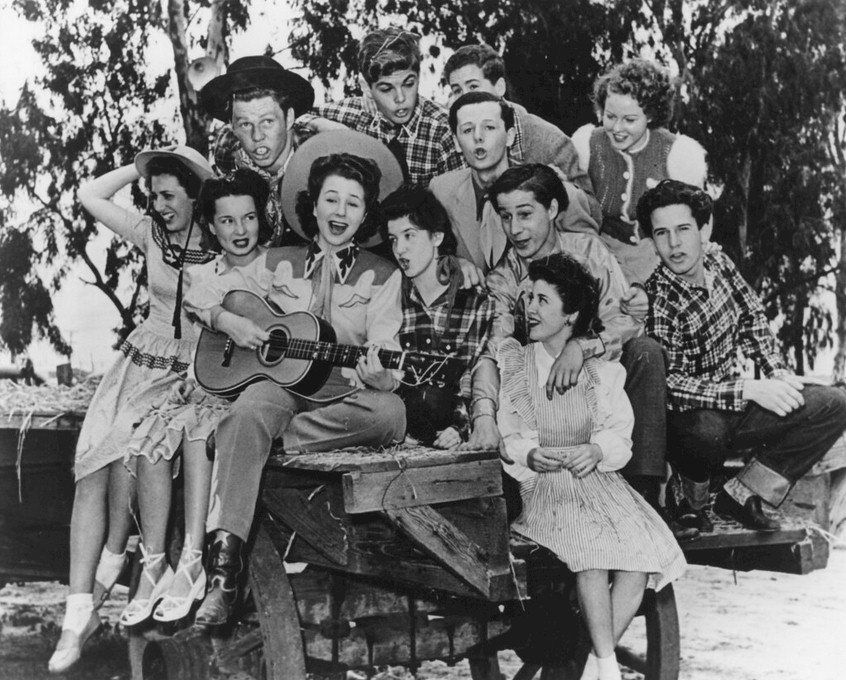
Jeffries Barn, April 12, 1942
"Jane Withers will celebrate her 16th birthday next Sunday with a hayride and old-fashioned barn dance at Jim Jeffries' barn."
(It is not clear to me if Dickie Moore got Jane Withers' age wrong or if the date in the caption is correct and Jane Withers had two birthday parties at the Barn. Jane is playign the guitar. Dickie Moore is the boy at the very top. Bobby Jordan is the boy with his arm on the shoulder of the girl whom I assume is Edith Fellows. Freddie Bartholomew is above Jordan. Not sure of the others. - Wes)
8/14/19, From Mike McDaniel: "I have finally found information on James Jeffries' wife and daughter. The pictures here are from a passport application from June 3, 1921. It appears that Freda Jeffries, James Jeffries' wife, was a German citizen and his daughter was adopted. I think the daughter is the wifes child but not Jeffries'. She married a guy named Roberts and she named her kids in Jeffries' Honor. Their first son was James Jeffries Roberts. She and the son are buried in Valhalla with the same headstone. James J. Jeffries and wife are buried in Inglewood cemetery." Mike